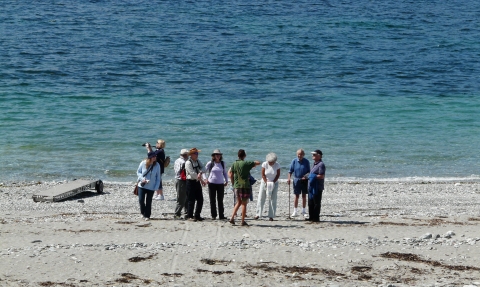
Jon Ross
Visiting

(c) Claire Lewis
2026 Day Trips to Looe Island
Day trips to Looe Island will return in spring 2026. Please check this page for the timetable next year.
Information
All visits are weather and tide dependent. The crossing via a small passenger boat takes 20 minutes and, unless advised otherwise when you book, you will have about two hours to explore.
Please note that visits can only be made on official, organised trips and access by any other means is not allowed.
The island and its foreshore is managed for the benefit of wildlife and our team are working incredibly hard to keep Looe Island Nature Reserve special. Craft such as boats, jet skis, kayaks/canoes and paddleboards etc as well as snorkelers/divers and swimmers are therefore asked to respect the no landing sign.
Please understand that part of the island's appeal for many visitors is its tranquillity and an escape from the intrusions which are often a part of mainland life. The use of camera drones is therefore considered intrusive and unacceptable. Fishing is also not allowed on the island during two hour visits.
Where to get the boat
Board the boat from the floating pontoon, near the RNLI lifeboat station slipway in East Looe. The boat operator, Looe Sea Safari, also have an office on the quayside so can point you in the right direction.
What to expect from your trip
Access to the island involves climbing over the side of the boat onto a small landing trolley. Care is also needed to negotiate the swash of the waves which can cover the trolley. Please note that there is limited assistance to get on/off the boat. If necessary, please contact us to discuss.
Once landed on the island, visitors will be greeted by a warden and given a brief introduction to the nature reserve.
You will then be led across the sand and shingle beach up a simple sloping path to the Tractor Shed. This is where landing fees will be collected. Here you will be offered a copy of the trail guide and shown the start of the path around the island.
The path around the whole island is less that 1km long and can be comfortably walked in around 30 minutes. However most people take up to one hour 30 minutes to slowly walk around, reading the trail guide and taking in the wildlife and scenery as they go.
Please note that there are some steps and parts of the trail are steep, uneven, and slippery, so we recommend wearing appropriate footwear.
Respect areas that are closed. This is often to reduce wildlife disturbance or for safety reasons and includes the main house/cottages plus most outbuildings/sheds etc.
At the end of the trail please place guides in the container so that they can be cleaned ready to be re-used.
Facilities on the island
There is a simple compost toilet for public use. It is a dry system so hand sanitiser is available. There is no drinking water, nor refreshments/snacks on the island - please bring your own supplies. Please take all of your waste/recycling home with you - we suggest bringing your own waste bag.
The Tractor Shed also acts as a basic visitor centre where there is a table top shop with a few items for sale to help raise funds for Cornwall Wildlife Trust.
To keep the island safe and special, and to help protect wildlife, landing and access is only permitted via the authorised boat.
Booking information
Please visit the website of the boat operator, Looe Sea Safari or call them on 07415321072 to book your trip. The number of passengers on the boat is normally restricted to 11. The small passenger boat (Evie J) can access the island up to two to three hours either side of high tide, in daylight hours and in fair weather. Trips cannot take place at low tide or in rough seas.
Return boat fee: £12 per adult and £6 per child (aged 10 or under) payable upon booking the boat. Landing fee (paid on island): £8 per adult and £3 per child (aged 10 or under)
Looe Island Nature Highlights
Looe Island Summer Update: A Butterfly Bonanza Year
Looe Island Assistant Warden Claire provides a summer update from Looe Island which is experiencing a butterfly boom this summer,…
Looe Island: a winter update
A winter update from Looe Island including kingfishers, cormorants, seals and catkins.
An autumnal update from Looe Island Nature Reserve
As autumn arrives on Looe Island, Island Warden Claire reflects on the changing season and key species who visited over the summer, and…
